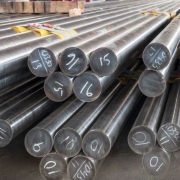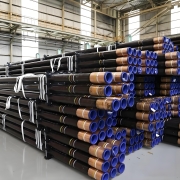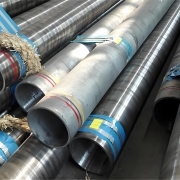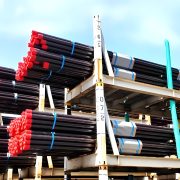知っておくべきことすべて: スーパー 13Cr
1. はじめにと概要
スーパー13Cr は、優れた機械的強度と中程度の耐腐食性で知られるマルテンサイト系ステンレス鋼合金で、厳しい環境に最適です。もともと石油およびガス用途向けに開発されたスーパー 13Cr は、特に塩化物による応力腐食割れ (SCC) が懸念される中程度の腐食性環境で、高合金材料に代わるコスト効率の高い代替品となります。
スーパー 13Cr は、従来の 13Cr ステンレス鋼に比べて機械的特性が強化され、耐腐食性も向上しているため、石油・ガス、化学処理、パルプ・製紙、海洋・沖合、大気汚染制御、発電などの業界で広く使用されています。
2. 入手可能なスーパー13Cr製品と仕様
Super 13Cr は、多様な用途要件を満たすためにさまざまな形で提供されています。
- UNS番号: S41426
- 通称: スーパー13Cr
- W.Nr.: 1.4009
- ASTM/ASME規格: ASTM A276、A479、A182
- 製品形態: パイプ、 チューブ、 バー、 ロッド、 鍛造ストック
3. スーパー13Crの用途
スーパー 13Cr は、強度、硬度、耐腐食性を兼ね備えているため、さまざまな用途に適しています。
- オイルとガス: CO₂および限られたH₂Sへの曝露を伴う軽度の腐食性環境におけるチューブ、ケーシング、およびパイプライン。
- 化学処理: 中程度の攻撃性化学物質を取り扱う機器および配管システム。
- パルプ・紙: 過酷な化学処理環境にさらされるコンポーネント。
- 海洋・オフショア: ポンプ、バルブ、その他の海洋構造物を含む海水処理のコンポーネント。
- 発電蒸気タービンのブレードと部品は高温と腐食にさらされます。
- 大気汚染制御: 腐食性の煙道ガスや酸性環境にさらされるコンポーネント。
- 食品加工: 衛生と耐腐食性が重要となる環境で使用される機器。
- 高効率住宅用暖房機: 高温下でも耐久性のある素材を使用した熱交換器。
4. 耐腐食性
スーパー 13Cr は、特に CO₂ を含む環境では、従来の 13Cr ステンレス鋼よりも優れた耐食性を発揮します。ただし、硫化物応力割れのリスクがあるため、H₂S 含有量が多い環境には適していません。この合金は、塩化物を含む環境で優れた孔食および隙間腐食耐性を発揮し、中程度の塩化物濃度では応力腐食割れに耐性があります。
5. 物理的および熱的特性
- 密度: 7.7 g/cm³
- 融点範囲: 1,400~1,450℃
- 熱伝導率: 20°Cで25 W/mK
- 比熱: 460 J/kg·K
- 熱膨張係数: 10.3 x 10⁻⁶/°C (20~100°C)
6. 化学組成
スーパー 13Cr の一般的な化学組成は次のとおりです。
- クロム (Cr): 12.0–14.0%
- ニッケル(Ni): 3.5–5.5%
- モリブデン (Mo): 1.5–2.5%
- 炭素(C): ≤0.03%
- マンガン (Mn): ≤1.0%
- シリコン(Si): ≤1.0%
- リン(P): ≤0.04%
- 硫黄(S): ≤0.03%
- 鉄(Fe): バランス
7. 機械的性質
- 抗張力: 690~930MPa
- 降伏強度: 550~650MPa
- 伸長: ≥20%
- 硬度: 250~320 HB
- 耐衝撃性: 特に熱処理後は優れています。
8. 熱処理
スーパー 13Cr は通常、熱処理によって硬化され、機械的特性が向上します。熱処理プロセスには、望ましい強度と靭性の組み合わせを達成するための焼き入れと焼き戻しが含まれます。一般的な熱処理サイクルには次のものが含まれます。
- 溶液アニーリング950~1050℃に加熱し、その後急速に冷却します。
- 焼き入れ:硬度と靭性を調整するために600~700℃に再加熱します。
9. 形成
スーパー 13Cr は熱間成形または冷間成形が可能ですが、強度が高く延性が低いため、オーステナイト系グレードよりも成形が困難です。ひび割れを防ぐために、成形前の予熱と成形後の熱処理が必要になることがよくあります。
10. 溶接
スーパー 13Cr の溶接では、割れを防ぎ、耐腐食性を維持するために、慎重な管理が必要です。通常、予熱と溶接後熱処理 (PWHT) が必要です。溶接品質を確保するには、フィラー材料がスーパー 13Cr に適合している必要があります。水素脆化を回避するために、特別な注意が必要です。
11. 溶接部の腐食
Super 13Cr の溶接部は、特に熱影響部 (HAZ) で局部腐食の影響を受けやすくなります。耐腐食性を回復し、残留応力を軽減し、溶接部の靭性を向上させるには、溶接後の熱処理が重要です。
12. スケール除去、酸洗い、洗浄
スーパー 13Cr のスケール除去は、熱処理中に強固な酸化スケールが形成されるため、困難になることがあります。スケールを除去するには、ブラストなどの機械的方法や酸洗い溶液を使用した化学処理を採用できます。合金は、汚染を防ぎ、最適な耐腐食性を確保するために、酸洗い後に徹底した洗浄が必要です。
13. 表面硬化
Super 13Cr は、耐腐食性を損なうことなく耐摩耗性を高めるために、窒化などの表面硬化処理を施すことができます。窒化は、研磨性および高摩擦環境における合金の耐久性を向上させるのに役立ちます。
結論
Super 13Cr は、中程度の耐腐食性と高い機械的強度が求められる業界に、多用途のソリューションを提供します。バランスのとれた特性により、石油・ガス、化学処理、海洋用途などで人気があります。耐腐食性から溶接性まで、その独自の特性を理解することで、エンジニアや材料専門家は、特定の環境での性能と寿命を最適化するための情報に基づいた決定を下すことができます。
このブログ投稿では、Super 13Cr の仕様と特性の包括的な概要を提供し、この高度な材料を最大限に活用するための知識を業界に提供します。





